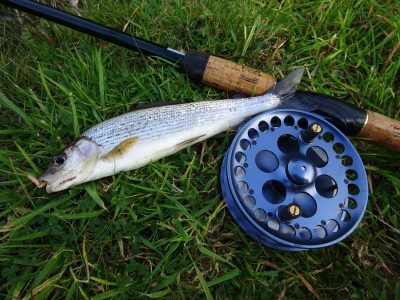It’s been ages since I’ve managed to update the blog. A new job, a new garden and generally life keeps me busy but it’s good to sit down think about the recnt activity.
In September we ran two sessions for the local St Austell Explorer Scout Group. We had a couple of hours in the evening just as autumn was setting in. The cooler evenings temerpatures however didn’t slow down the fishing and between them they caught loads of great roach and rudd on simple whip fishing tactics. Many of the fish were “first fish” and as ever the look of delight on the faces was present. I honestly don’t think I can remember a first fish that isn’t met with a big smile and wide eyes, brilliant!
Today, the stars, or rather my diary aligned so I could squeeze in a couple of hours fishing after work. I was close to a section of river I’ve wanted to fish for a while so since the Grayling season was in full flow I got my ticket, a pint of maggots and my trusty centre pin reel and found myself by a beautiful stretch of water. The centre pin reel is an absolute pleasure to use. I’m fortunate to own one by Adcock Stanton and it is a stunning piece of engineering.
After the recent rain, the water was carrying a lot of colour, more than I was expecting but it still looked inviting and I wasn’t about to start making my excuses before I had even got started. Tackle was very simple, a 12ft float fishing rod, 4lb Drennan Supplex line, a loafer float that carried two swan shot and a barbless size 16 hook that would carry two maggots for bait.
My previous experience of Grayling has taught me to look for smooth glides in the river. The water doesn’t need to be deep, eighteen inches is enough but they don’t seem to like much turbulence. I found an ideal looking spot at the top of the beat just below a pretty bridge. I fed maggots into the swim for about ten minutes before making my first cast. Feeding a swim like this before you cast can really increase your chances. Get the fish feeding first, then when you cast, bites should come very quickly.
The first couple of bites were fast and I missed them but I some got into the swing of things and the first Grayling of the day came splashing to hand. They reall are special fish and after a quick photo it was returned to the water. A couple more fish from that particular section of river and I was off exploring. It’s always so nice walking along a river, looking for signs of fish, trying a few spots here and there and catching a few along the way.
It always pays to thnk about what you’re doing as you go and see what you can learn. Today the fish wanted the bait trooted down stream at a slow pace. Using the centre pin is the best way to help control the speed at which your bait drifts ot “trots” down stream. After casting the float will travel downstream and line will peel off the real. By applying a little thumb pressure on the revolving drum you can slow the pace of the line down and therefore the speed at which the bait travels down the river. Some days fish want it fished at the pace of the river, others, fished much slower. The fun is working out just what they want.
None of the fish caught were particularly big but all put up a good scrap and in such beautiful surroundings I couldn’t help but enjoy myself. The action was interupted by an out of season brown trout, but just the one. The couple of hours raced by and soon it was time to head for home.
If you fancy joining me for a special Grayling adventure, drop me a line at info@theschooloffish.co.uk
